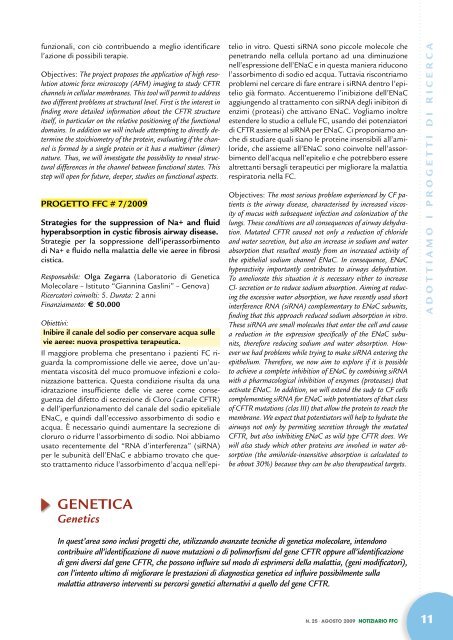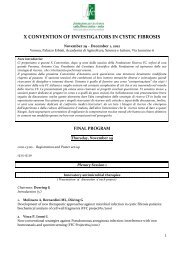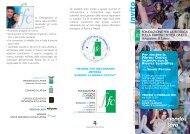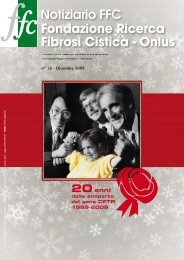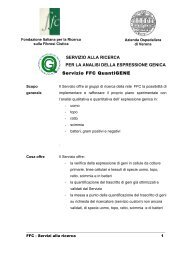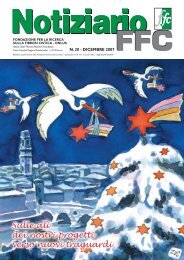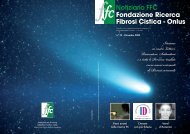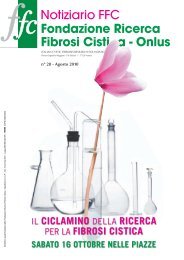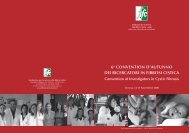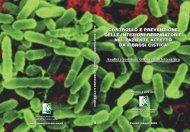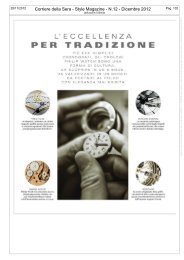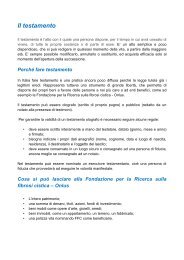Notiziario n. 25 - Fondazione Ricerca Fibrosi Cistica
Notiziario n. 25 - Fondazione Ricerca Fibrosi Cistica
Notiziario n. 25 - Fondazione Ricerca Fibrosi Cistica
You also want an ePaper? Increase the reach of your titles
YUMPU automatically turns print PDFs into web optimized ePapers that Google loves.
funzionali, con ciò contribuendo a meglio identificare<br />
l’azione di possibili terapie.<br />
Objectives: The project proposes the application of high resolution<br />
atomic force microscopy (AFM) imaging to study CFTR<br />
channels in cellular membranes. This tool will permit to address<br />
two different problems at structural level. First is the interest in<br />
finding more detailed information about the CFTR structure<br />
itself, in particular on the relative positioning of the functional<br />
domains. In addition we will include attempting to directly determine<br />
the stoichiometry of the protein, evaluating if the channel<br />
is formed by a single protein or it has a multimer (dimer)<br />
nature. Thus, we will investigate the possibility to reveal structural<br />
differences in the channel between functional states. This<br />
step will open for future, deeper, studies on functional aspects.<br />
Progetto FFC # 7/2009<br />
Strategies for the suppression of Na+ and fluid<br />
hyperabsorption in cystic fibrosis airway disease.<br />
Strategie per la soppressione dell’iperassorbimento<br />
di Na+ e fluido nella malattia delle vie aeree in fibrosi<br />
cistica.<br />
Responsabile: Olga Zegarra (Laboratorio di Genetica<br />
Molecolare – Istituto “Giannina Gaslini” – Genova)<br />
<strong>Ricerca</strong>tori coinvolti: 5. Durata: 2 anni<br />
Finanziamento: € 50.000<br />
Obiettivi:<br />
Inibire il canale del sodio per conservare acqua sulle<br />
vie aeree: nuova prospettiva terapeutica.<br />
Il maggiore problema che presentano i pazienti FC riguarda<br />
la compromissione delle vie aeree, dove un’aumentata<br />
viscosità del muco promuove infezioni e colonizzazione<br />
batterica. Questa condizione risulta da una<br />
idratazione insufficiente delle vie aeree come conseguenza<br />
del difetto di secrezione di Cloro (canale CFTR)<br />
e dell’iperfunzionamento del canale del sodio epiteliale<br />
ENaC, e quindi dall’eccessivo assorbimento di sodio e<br />
acqua. È necessario quindi aumentare la secrezione di<br />
cloruro o ridurre l’assorbimento di sodio. Noi abbiamo<br />
usato recentemente del “RNA d’interferenza” (siRNA)<br />
per le subunità dell’ENaC e abbiamo trovato che questo<br />
trattamento riduce l’assorbimento d’acqua nell’epitelio<br />
in vitro. Questi siRNA sono piccole molecole che<br />
penetrando nella cellula portano ad una diminuzione<br />
nell’espressione dell’ENaC e in questa maniera riducono<br />
l’assorbimento di sodio ed acqua. Tuttavia riscontriamo<br />
problemi nel cercare di fare entrare i siRNA dentro l’epitelio<br />
già formato. Accentueremo l’inibizione dell’ENaC<br />
aggiungendo al trattamento con siRNA degli inibitori di<br />
enzimi (proteasi) che attivano ENaC. Vogliamo inoltre<br />
estendere lo studio a cellule FC, usando dei potenziatori<br />
di CFTR assieme al siRNA per ENaC. Ci proponiamo anche<br />
di studiare quali siano le proteine insensibili all’amiloride,<br />
che assieme all’ENaC sono coinvolte nell’assorbimento<br />
dell’acqua nell’epitelio e che potrebbero essere<br />
altrettanti bersagli terapeutici per migliorare la malattia<br />
respiratoria nella FC.<br />
Objectives: The most serious problem experienced by CF patients<br />
is the airway disease, characterised by increased viscosity<br />
of mucus with subsequent infection and colonization of the<br />
lungs. These conditions are all consequences of airway dehydration.<br />
Mutated CFTR caused not only a reduction of chloride<br />
and water secretion, but also an increase in sodium and water<br />
absorption that resulted mostly from an increased activity of<br />
the epithelial sodium channel ENaC. In consequence, ENaC<br />
hyperactivity importantly contributes to airways dehydration.<br />
To ameliorate this situation it is necessary either to increase<br />
Cl- secretion or to reduce sodium absorption. Aiming at reducing<br />
the excessive water absorption, we have recently used short<br />
interference RNA (siRNA) complementary to ENaC subunits,<br />
finding that this approach reduced sodium absorption in vitro.<br />
These siRNA are small molecules that enter the cell and cause<br />
a reduction in the expression specifically of the ENaC subunits,<br />
therefore reducing sodium and water absorption. However<br />
we had problems while trying to make siRNA entering the<br />
epithelium. Therefore, we now aim to explore if it is possible<br />
to achieve a complete inhibition of ENaC by combining siRNA<br />
with a pharmacological inhibition of enzymes (proteases) that<br />
activate ENaC. In addition, we will extend the sudy to CF cells<br />
complementing siRNA for ENaC with potentiators of that class<br />
of CFTR mutations (clas III) that allow the protein to reach the<br />
membrane. We expect that potentiators will help to hydrate the<br />
airways not only by permiting secretion through the mutated<br />
CFTR, but also inhibiting ENaC as wild type CFTR does. We<br />
will also study which other proteins are involved in water absorption<br />
(the amiloride-insensitive absorption is calculated to<br />
be about 30%) because they can be also therapeutical targets.<br />
ADOTTIAMO I PROGETTI DI RICERCA<br />
GENETICA<br />
Genetics<br />
In quest’area sono inclusi progetti che, utilizzando avanzate tecniche di genetica molecolare, intendono<br />
contribuire all’identificazione di nuove mutazioni o di polimorfismi del gene CFTR oppure all’identificazione<br />
di geni diversi dal gene CFTR, che possono influire sul modo di esprimersi della malattia, (geni modificatori),<br />
con l’intento ultimo di migliorare le prestazioni di diagnostica genetica ed influire possibilmente sulla<br />
malattia attraverso interventi su percorsi genetici alternativi a quello del gene CFTR.<br />
N. <strong>25</strong> • AGOSTO 2009 • NOTIZIARIO FFC<br />
11


